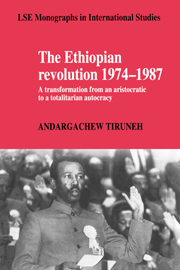 The Ethiopian Revolution 1974–1987
The Ethiopian Revolution 1974–1987 Published online by Cambridge University Press: 18 December 2009
Ethiopia is one of the few African countries that survived without being colonized by the Western powers. This fact, more than any other perhaps, kept her oblivious of Western political processes, notably the process concerned with political parties. An exception to this was Eritrea, which after having been under Italian colonial administration for about fifty years, came under British administration from 1941 to 1952 as an enemy-occupied territory. In the 1940s a number of political organizations sprang up around the question of the disposal of the territory. It is arguable whether those political organizations were ‘parties’, since they did not have a programme on questions other than the disposal of Eritrea; at any rate, with the federation of Eritrea with Ethiopia in 1952 by a decision of the UN General Assembly, the political organizations withered and died.
The last constitution of Haile Selassie's government, which was issued in 1955, provided that ‘every Ethiopian subject has the right to engage in any occupation and, to that end, to form or join associations in accordance with the law’. This was the only provision of the constitution that could arguably be interpreted to allow the right to form political organizations. Nevertheless, it strongly implies that the formation of an association has to be related to occupation, and hence, excludes the formation of political organizations. In reality too, there was never any public demand to form political organizations, and the general assumption was that the legal right to do so did not exist.
To save this book to your Kindle, first ensure [email protected] is added to your Approved Personal Document E-mail List under your Personal Document Settings on the Manage Your Content and Devices page of your Amazon account. Then enter the ‘name’ part of your Kindle email address below. Find out more about saving to your Kindle.
Note you can select to save to either the @free.kindle.com or @kindle.com variations. ‘@free.kindle.com’ emails are free but can only be saved to your device when it is connected to wi-fi. ‘@kindle.com’ emails can be delivered even when you are not connected to wi-fi, but note that service fees apply.
Find out more about the Kindle Personal Document Service.
To save content items to your account, please confirm that you agree to abide by our usage policies. If this is the first time you use this feature, you will be asked to authorise Cambridge Core to connect with your account. Find out more about saving content to Dropbox.
To save content items to your account, please confirm that you agree to abide by our usage policies. If this is the first time you use this feature, you will be asked to authorise Cambridge Core to connect with your account. Find out more about saving content to Google Drive.